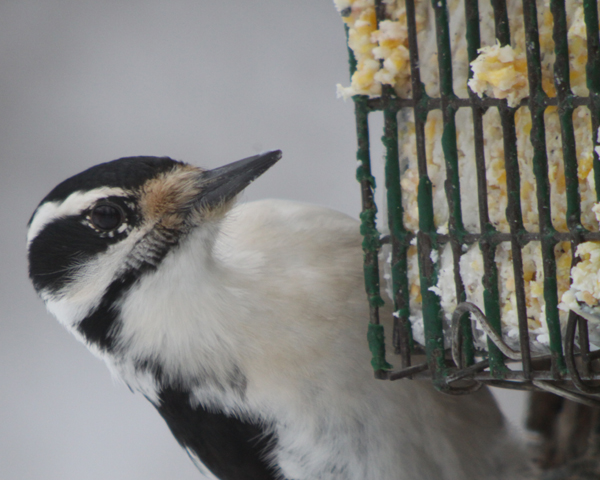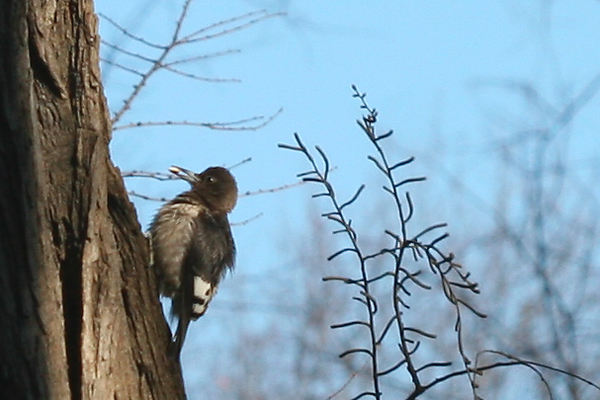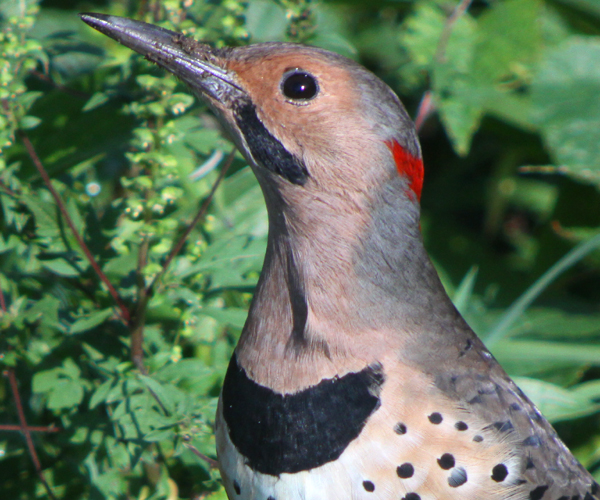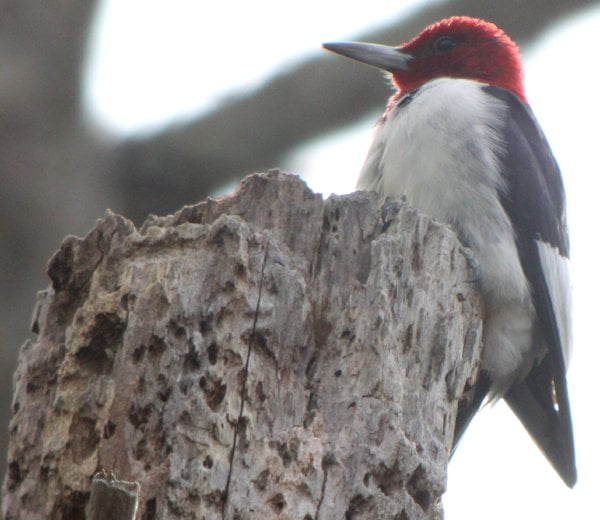Disbelief probably seems like the proper response to the idea that there are woodpeckers in New York City. After all, woodpeckers peck on trees, not skyscrapers. But Gotham’s many parks have some very suitable habitat for birds from the family Picidae and a birder in any borough of New York will generally find at least a couple of species during an average morning’s birding. But even birders might be surprised to learn that eight species of woodpecker have graced New York City’s five boroughs with their presence! Only six regularly appear in the city, however, and only four are year-round residents.
What are these woodpeckers and where is one likely to find them? Read on curious picophile, read on!
The Downy Woodpecker Picoides pubescens
Downy Woodpeckers can be found in every borough and in pretty much every park larger than a couple of square  blocks in New York City, to say nothing of residential neighborhoods with trees. They tend to be a confiding bird, willing to allow close approach, and they readily come to feeders for suet and even sunflower seeds. If you hear a gentle tapping coming from a stand of reeds you can be pretty sure that you are hearing a Downy Woodpecker, as they seem to be the only species in our area that regularly show that behavior. Like many woodpeckers, they are sexually dimorphic, with males showing a red spot on the back of their head. Otherwise, their coloration is a simple black-and-white like in the female bird above this paragraph. If you are going to see any single species of woodpecker in New York City, this is likely the one you will see. They are common but they have spunk which makes them well worth a look.
blocks in New York City, to say nothing of residential neighborhoods with trees. They tend to be a confiding bird, willing to allow close approach, and they readily come to feeders for suet and even sunflower seeds. If you hear a gentle tapping coming from a stand of reeds you can be pretty sure that you are hearing a Downy Woodpecker, as they seem to be the only species in our area that regularly show that behavior. Like many woodpeckers, they are sexually dimorphic, with males showing a red spot on the back of their head. Otherwise, their coloration is a simple black-and-white like in the female bird above this paragraph. If you are going to see any single species of woodpecker in New York City, this is likely the one you will see. They are common but they have spunk which makes them well worth a look.
The Red-bellied Woodpecker Melanerpes carolinus
Red-bellied Woodpeckers are the most recent to arrive of our year-round woodpeckers. Until the late 1950s they were  exceedingly rare in the region, being a bird, as you can probably guess by the scientific name, of the southern United States. In the last fifty years they have expanded their range northward at a pretty impressive pace, and are now widespread and common across all five boroughs. Though they do have a red belly that is very difficult to see* the red on their heads along with their black-and-white striped backs are their two easiest field marks when they are at rest. (I have actually heard them referred to as “ladder-backed woodpeckers” or “zebra-backed woodpeckers” but that first colloquial name should be avoided lest it cause confusion with the species of that name from the southwest.) In flight, watch for the white patch on each wing that shows at the base of their primaries. The easiest way to find Red-bellied Woodpeckers is to walk in the woods and listen for what sounds like a soft cough coming from up in a tree and then try to spot the bird making the sound.
exceedingly rare in the region, being a bird, as you can probably guess by the scientific name, of the southern United States. In the last fifty years they have expanded their range northward at a pretty impressive pace, and are now widespread and common across all five boroughs. Though they do have a red belly that is very difficult to see* the red on their heads along with their black-and-white striped backs are their two easiest field marks when they are at rest. (I have actually heard them referred to as “ladder-backed woodpeckers” or “zebra-backed woodpeckers” but that first colloquial name should be avoided lest it cause confusion with the species of that name from the southwest.) In flight, watch for the white patch on each wing that shows at the base of their primaries. The easiest way to find Red-bellied Woodpeckers is to walk in the woods and listen for what sounds like a soft cough coming from up in a tree and then try to spot the bird making the sound.
The Northern Flicker Colaptus auratus
Northern Flickers are most common in New York City during migration, especially fall migration, but some are year-round residents. They breed in all five boroughs and can be readily identified in flight by their flashing yellow underwings and white rump. If you happen to see a flicker with red underwings make sure to get the word out – that would be the western subspecies, the Red-shafted Flicker, and would be an extremely notable sighting and likely unprecedented in New York City! Male Yellow-shafted Flickers, our eastern subspecies, can be told from females by the presence of a bold black moustachial stripe. If you see a woodpecker feeding on a lawn it is almost guaranteed to be a Northern Flicker as they turn the tables on ants, so to speak, by picnicking on them.
The Hairy Woodpecker Picoides villosus
Hairy Woodpeckers are essentially Downy Woodpeckers writ large, though they are much more scarce in the city.  They are most likely to be found in areas with large tracts of forest like Van Cortlandt Park in the Bronx, Forest Park in Queens, or North Mount Loretto State Forest in Staten Island. The easiest way to tell a hairy from a downy is by the length of the bill. If the bill is as long as the head is then you have a Hairy Woodpecker while a bill half the length of the head is a Downy Woodpecker. Another field mark, helpful when seeing woodpeckers from behind, is the black line bisecting the red spot on the back of the Hairy Woodpecker‘s head, which you can see in the shot of the preening bird above this paragraph. Downy Woodpeckers have a solid red spot.
They are most likely to be found in areas with large tracts of forest like Van Cortlandt Park in the Bronx, Forest Park in Queens, or North Mount Loretto State Forest in Staten Island. The easiest way to tell a hairy from a downy is by the length of the bill. If the bill is as long as the head is then you have a Hairy Woodpecker while a bill half the length of the head is a Downy Woodpecker. Another field mark, helpful when seeing woodpeckers from behind, is the black line bisecting the red spot on the back of the Hairy Woodpecker‘s head, which you can see in the shot of the preening bird above this paragraph. Downy Woodpeckers have a solid red spot.
The Red-headed Woodpecker Melanerpes erythrocephalus
Red-headed Woodpeckers at one time migrated through New York City in large numbers.  Now that flood of birds has been reduced to a trickle with the breeding populations north of the city greatly reduced and only a few birds are reported each year. Some, however, stick around for the entire winter, with Central Park being perhaps the most likely place for one to stay though recent wintering birds in Queens and Staten Island show that Red-headed Woodpeckers, if they find proper habitat, can winter anywhere in the city. Adults are easily recognizable with their bright red head and strongly contrasting black-and-white bodies though juveniles like the one at right might throw an observer for a loop with their plain brown heads. Perhaps one of the coolest thing about wintering Red-headed Woodpeckers in New York City is that they are often juveniles and they gradually go from being a plain-Jane youngster to a ravishing redhead as they molt into adult plumage.
Now that flood of birds has been reduced to a trickle with the breeding populations north of the city greatly reduced and only a few birds are reported each year. Some, however, stick around for the entire winter, with Central Park being perhaps the most likely place for one to stay though recent wintering birds in Queens and Staten Island show that Red-headed Woodpeckers, if they find proper habitat, can winter anywhere in the city. Adults are easily recognizable with their bright red head and strongly contrasting black-and-white bodies though juveniles like the one at right might throw an observer for a loop with their plain brown heads. Perhaps one of the coolest thing about wintering Red-headed Woodpeckers in New York City is that they are often juveniles and they gradually go from being a plain-Jane youngster to a ravishing redhead as they molt into adult plumage.
The Yellow-bellied Sapsucker Sphyrapicus varius
Yellow-bellied Sapsuckers, like Red-headed Woodpeckers, are migrants through and winter visitors to New York City. They are a much more common species than red-heads, however, and they even winter in tiny patches of habitat like Manhattan’s Union Square Park. They come by their name honestly, having a yellow wash on their underparts and a proclivity for drilling holes in trees and sucking down the sap that then bleeds from the tree. Other species often take advantage of the sapsuckers’ wells, most famously in New York City the Scott’s Oriole that graced us with its presence back in 2008. Males have red on their head and on the throat while females only have it on the head. Juveniles lack red altogether. The best way to distinguish a sapsucker from the other woodpeckers in New York City is the lack of stark contrast. Other than the bright white wing stripe they look kind of mottled and lack the clear black-and-white pattern that most of the rest of our woodpeckers have.
The Pileated Woodpecker Dryocopus pileatus
Pileated Woodpecker images above and below are by Christopher Ciccone (used with permission)
Pileated Woodpeckers are rare visitors to New York City, with one from Queens in the winter of 1981-1982, one  reported in the northern part of the Bronx in 2009, and several records from Staten Island in the last twenty years the only reports in a very long time. They were never common in New York City and the only records I could find are as follows: one in the Bronx’s Bronx Park in 1939 and another in Van Cortlandt Park in 1962; birds in Manhattan’s Fort Tryon Park in 1959 and Inwood Hill Park in 1961; and there were specimens taken in East New York, Brooklyn, in the 1840s and in Jamaica, Queens, in 1879. It seems likely that eventually a population will take root in the Bronx because Pileated Woodpeckers are relatively common in Westchester County, which is just north of the Bronx, and Bergen County, New Jersey, just across the Hudson River. It seems unlikely that they would be unreported if they were present anywhere in the city for any length of time considering their size and unmistakable appearance.
reported in the northern part of the Bronx in 2009, and several records from Staten Island in the last twenty years the only reports in a very long time. They were never common in New York City and the only records I could find are as follows: one in the Bronx’s Bronx Park in 1939 and another in Van Cortlandt Park in 1962; birds in Manhattan’s Fort Tryon Park in 1959 and Inwood Hill Park in 1961; and there were specimens taken in East New York, Brooklyn, in the 1840s and in Jamaica, Queens, in 1879. It seems likely that eventually a population will take root in the Bronx because Pileated Woodpeckers are relatively common in Westchester County, which is just north of the Bronx, and Bergen County, New Jersey, just across the Hudson River. It seems unlikely that they would be unreported if they were present anywhere in the city for any length of time considering their size and unmistakable appearance.
The Black-backed Woodpecker Picoides arcticus
Black-backed Woodpecker by Christopher Ciccone (used with permission)
Black-backed Woodpeckers haven’t been seen in New York City since one was seen and photographed in Central Park in 1958. Formerly, it was a very rare visitor that would show up in the region during occasional winter irruptions from its breeding areas which, as its scientific name implies, are in the far north, with the Adirondack Mountains being its closest stronghold and likeliest origin of the birds that showed up in New York City. Black-backed Woodpeckers would often stay in one place for an extended period, according to John Bull’s Birds of the New York City Area, and one bird stayed at the New York Botanical Gardens in the Bronx from 14 November 1926 until 31 January 1927.
…
*Red-bellied Woodpeckers, like almost all birds, were named by a person who had the bird in the hand and who could therefore see some plumage details that might be difficult to see in the field.
…
Thanks to Mike Shanley and Seth Wollney for information about woodpecker sightings in Staten Island and to Christopher Ciccone for the use of his images. I also relied upon information I gathered from eBird, John Bull’s Birds of the New York Area, and The Second Atlas of Breeding Birds in New York State to write this post.
………





















That’s a mighty fine post, Corey!
You now officially deserve to find a Black-backed in Queens.
I think he deserves to find a Three-toed in Queens.
Well, I’ll give him Black-backed this year despite our competition. Because he is such a nice guy. Next year, Three-toed.
Deal?
@Jochen: Thanks, and that is a deal!
@Kirby Adams: I like the way you think!
Nice post! About the Black-backed Woodpecker; is there a copy of the 1958 photo anywhere? Excuse me if it’s on your post (my browser seems to block the picture of that species in your post).
@Sam S: I didn’t try to track it down but it must be somewhere…and, no worries, that picture on the post is acting weird and I’m not sure why.
“Disbelief”? I think it’s time to retire the trope about being surprised to discover that the city is full of birds, especially on a blog like this one. There’s an old saying that if you sit by the riverbank long enough you’ll see your enemies float by, and if you bird watch in the city long enough, all sorts of interesting species will pass by your bins. In addition to the three hundred-plus species on my NYC/western Long Island and surrounding ocean checklist, I can think of the Western Reef Heron, Scott’s Oriole, Rufus Hummingbird, Boreal Owl, Varied Thrush, Hooded Crow, and Grey-headed Gull as some of the rarities found within NYC since I started bird-watching a decade or so ago.
@Matthew, I certinaly didn’t mean to doubt the authenticity of a Black-backed Woodpecker in Central Park. On the contrary I was more surprised that there has been only one. I just enjoy seeing photos of rarities and it sounds like a historically relivant shot that is worth preserving!
@Matthew: I regularly encounter people who profess surprise at the idea that there are lots of birds in New York City. Outside of the birding world it seems that many people have no idea.
@Sam S: My comment was only about Corey’s use of the disbelief trope or cliche.
@Corey: Precisely why we need to treat the actual reality of the situation like the actual reality without falling into the too-easy tabloid-mode of would-you-believe-it, which I see so often hence my desire to see it no more. Mine is a criticism of rhetorical style, i suppose, but one, I think, with a point. We’ve a long way to go in educating people about the natural world around them, to be sure.
thanks for the great story on our woodpeckers… I know I enjoy a robust crowd of Red-bellied, Downy, & Hairy that overwinter in Forest Park, and this year I also had a male Yellow-bellied Sapsucker stick around.
@Jean L: Most of these shots were taken at Forest Park of the very birds to which you refer.
Rare Endangered Woodpecker Spotted In New York City
recent siting in brooklyn of all placed. see below.
http://www.youtube.com/watch?v=4YsKY3HYPBs
@dave: The woodpecker in your video is a Red-bellied Woodpecker, which, if you bothered to read this post, you would realize is “widespread and common across all five boroughs.” It is neither rare nor endangered.
I think I just saw a red bellied woodpecker in my backyard in Brooklyn. It was pretty fat and quite large–maybe a foot long. The back of its head was red and its wings and back were striped, but its coloration was much more like the flicker than than the image of the red-belly I see above. Have I identified it correctly, do you think? I’ll post a photo if it comes back!
On second thought, maybe it was a flicker.
@Adam: Probably a flicker, as they are bigger than a Red-bellied. If I saw a Red-bellied Woodpecker that was a foot long I think I would run!
Today I saw a male Yellow-Bellied Sapsucker in Stuyvesant Square Park (Manhattan) I watched it drilling into a tree near my bench for several minutes. My first ever sighting of a woodpecker in New York.
What a treat!
I saw a Pileated Woodpecker at Ewen Park in Riverdale today. It was the first time I’d ever seen one.
I saw a red-bellied (‘laddback’) bird pecking away a couple of winters ago in Ft. Tryon Park, in Northern Manhattan.
I also saw one a couple of weeks ago by the fence along Pelham Parkway of the NY Botanical Garden. This one was dead. It had not been mauled in any way & there was nothing such as crustiness around the eyes to suggest disease. I took it in my hand & it seemed to me it still felt warm.
I felt very sad. I also wondered how it had died & whether there was anyone or anyplace it should have been reported, in case, something other than age, such as rat poison, was responsible.
I am not a birder. I love all animals & was on my way home from the Bronx Zoo. Was there anything I should have done?
Not sure if this is still an active site, but I saw a Pilates Woodpecker in our backyard in Brooklyn this morning. It was pecking at the old utility pole of all places.
So beautiful birds living in a very busy city! Good job for NY keeping their habitats safe.
I saw a Northern Flicker woodpecker red spot on back of head, the black stripe on its neck and black spots on its belly but it was completely dark brown on its entire body here in northwestern Pennsylvania. Ive never saw a bird like this before.